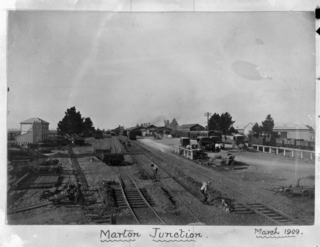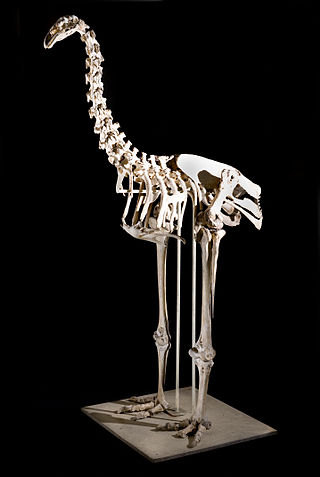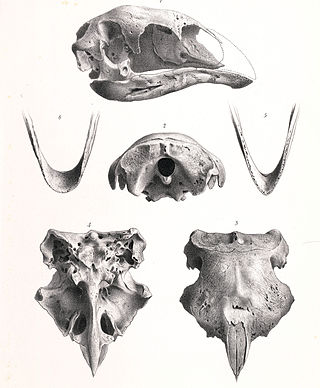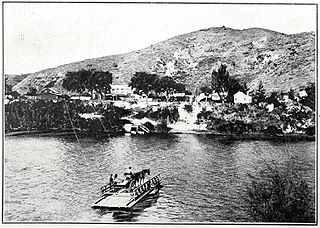
Moa are an extinct group of flightless birds formerly endemic to New Zealand. During the Late Pleistocene-Holocene, there were nine species. The two largest species, Dinornis robustus and Dinornis novaezelandiae, reached about 3.6 metres (12 ft) in height with neck outstretched, and weighed about 230 kilograms (510 lb) while the smallest, the bush moa, was around the size of a turkey. Estimates of the moa population when Polynesians settled New Zealand circa 1300 vary between 58,000 and approximately 2.5 million.

Whanganui, also spelt Wanganui, is a city in the Manawatū-Whanganui region of New Zealand. The city is located on the west coast of the North Island at the mouth of the Whanganui River, New Zealand's longest navigable waterway. Whanganui is the 19th most-populous urban area in New Zealand and the second-most-populous in Manawatū-Whanganui, with a population of 42,500 as of June 2024.

Manawatū-Whanganui is a region in the lower half of the North Island of New Zealand, whose main population centres are the cities of Palmerston North and Whanganui. It is administered by the Manawatū-Whanganui Regional Council, which operates under the name Horizons Regional Council.

Whanganui Collegiate School is a state-integrated, coeducational, day and boarding, secondary school in Whanganui, Manawatū-Whanganui region, New Zealand. The school is affiliated to the Anglican church.

Marton is a town in the Rangitikei district of the Manawatū-Whanganui region of New Zealand's North Island. It is situated 35 kilometres southeast of Whanganui and 40 kilometres northwest of Palmerston North.

The Whanganui River is a major river in the North Island of New Zealand. It is the country's third-longest river, and has special status owing to its importance to the region's Māori people. In March 2017 it became the world's second natural resource to be given its own legal identity, with the rights, duties and liabilities of a legal person. The Whanganui Treaty settlement brought the longest-running litigation in New Zealand history to an end.

The bush moa, little bush moa, or lesser moa is an extinct species of moa from the family Emeidae endemic to New Zealand.

The upland moa is an extinct species of moa that was endemic to New Zealand. It is a ratite, a grouping of flightless birds with no keel on the sternum. It was the last moa species to become extinct, vanishing around 1500 CE, and was predominantly found in alpine and sub-alpine environments.

The Whanganui Chronicle is New Zealand's oldest newspaper. Based in Whanganui, it celebrated 160 years of publishing in September 2016. It is the main daily paper for the Whanganui, Ruapehu and Rangitīkei regions, including the towns of Patea, Waverley, Whanganui, Bulls, Marton, Raetihi, Ohakune and National Park.

The heavy-footed moa is a species of moa from the lesser moa family. The heavy-footed moa was widespread only in the South Island of New Zealand, and its habitat was the lowlands. The moa were ratites, flightless birds with a sternum without a keel. They also have a distinctive palate. The origin of these birds is becoming clearer as it is now believed that early ancestors of these birds were able to fly and flew to the southern areas in which they have been found.

The North Island giant moa is an extinct moa in the genus Dinornis, known in Māori as kuranui. Even though it might have walked with a lowered posture, standing upright, it would have been the tallest bird ever to exist, with a height estimated up to 3.6 metres (12 ft).

The South Island giant moa is an extinct species of moa in the genus Dinornis, known in Māori by the name moa nunui. It was one of the tallest-known bird species to walk the Earth, exceeded in weight only by the heavier but shorter elephant bird of Madagascar.

The broad-billed moa, stout-legged moa or coastal moa is an extinct species of moa that was endemic to New Zealand.

Hōri Pukehika was a New Zealand Māori tribal leader and woodcarver.

Whanganui High School is a large state co-educational New Zealand secondary school located in Whanganui, New Zealand. Founded in 1958, the school has a roll of 1479 students, including international students as of July 2018, making it the largest school in Whanganui.

Upokongaro or Ūpokongaro is a settlement adjacent to the Whanganui River, located 12 kilometres (7.5 mi) upriver from Whanganui, New Zealand, in the Makirikiri Valley. Settled by Europeans in the 1860s, it was an important ferry crossing and riverboat stop. A spectacular discovery of moa bones was made in the area in the 1930s.

Annette Kay Main is a New Zealand local-body politician. She served as mayor of Whanganui from 2010 to 2016, and was the first woman to hold that office.

Michael R. Dickison is a New Zealand museum curator, zoologist and Wikipedia editor. He was New Zealand's first Wikipedian at Large, in 2018–19, receiving a grant from the Wikimedia Foundation.
Lauren Lysaght is a New Zealand multidisciplinary artist. Her works are held in the collection of the Auckland Art Gallery Toi o Tāmaki, the Museum of New Zealand Te Papa Tongarewa, and the Sarjeant Gallery. She has exhibited widely in New Zealand since the early 1980s.
Violet Emily Whiteman was an English-born New Zealand artist. Her work is in the permanent collection of the Sarjeant Gallery in Whanganui, New Zealand. Her paintings depict farm animals and pets, including foxes, dogs and horses.





















